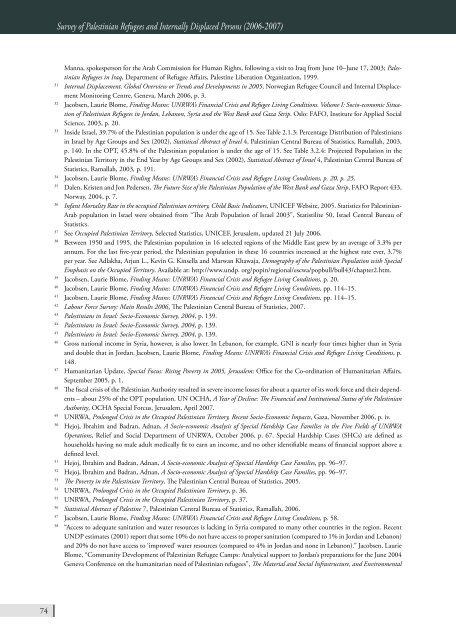BADIL Resource Center for Palestinian Residency and Refugee
BADIL Resource Center for Palestinian Residency and Refugee
BADIL Resource Center for Palestinian Residency and Refugee
You also want an ePaper? Increase the reach of your titles
YUMPU automatically turns print PDFs into web optimized ePapers that Google loves.
74<br />
Survey of <strong>Palestinian</strong> <strong>Refugee</strong>s <strong>and</strong> Internally Displaced Persons (2006-2007)<br />
Manna, spokesperson <strong>for</strong> the Arab Commission <strong>for</strong> Human Rights, following a visit to Iraq from June 10–June 17, 2003; <strong>Palestinian</strong><br />
<strong>Refugee</strong>s in Iraq, Department of <strong>Refugee</strong> Affairs, Palestine Liberation Organization, 1999.<br />
31 Internal Displacement, Global Overview or Trends <strong>and</strong> Developments in 2005, Norwegian <strong>Refugee</strong> Council <strong>and</strong> Internal Displacement<br />
Monitoring Centre, Geneva, March 2006, p. 3.<br />
32 Jacobsen, Laurie Blome, Finding Means: UNRWA’s Financial Crisis <strong>and</strong> <strong>Refugee</strong> Living Conditions. Volume I: Socio-economic Situation<br />
of <strong>Palestinian</strong> <strong>Refugee</strong>s in Jordan, Lebanon, Syria <strong>and</strong> the West Bank <strong>and</strong> Gaza Strip. Oslo: FAFO, Institute <strong>for</strong> Applied Social<br />
Science, 2003, p. 20.<br />
33 Inside Israel, 39.7% of the <strong>Palestinian</strong> population is under the age of 15. See Table 2.1.3: Percentage Distribution of <strong>Palestinian</strong>s<br />
in Israel by Age Groups <strong>and</strong> Sex (2002), Statistical Abstract of Israel 4, <strong>Palestinian</strong> Central Bureau of Statistics, Ramallah, 2003,<br />
p. 140. In the OPT, 45.8% of the <strong>Palestinian</strong> population is under the age of 15. See Table 3.2.4: Projected Population in the<br />
<strong>Palestinian</strong> Territory in the End Year by Age Groups <strong>and</strong> Sex (2002), Statistical Abstract of Israel 4, <strong>Palestinian</strong> Central Bureau of<br />
Statistics, Ramallah, 2003, p. 191.<br />
34 Jacobsen, Laurie Blome, Finding Means: UNRWA’s Financial Crisis <strong>and</strong> <strong>Refugee</strong> Living Conditions, p. 20, p. 25.<br />
35 Dalen, Kristen <strong>and</strong> Jon Pedersen, The Future Size of the <strong>Palestinian</strong> Population of the West Bank <strong>and</strong> Gaza Strip, FAFO Report 433,<br />
Norway, 2004, p. 7.<br />
36 Infant Mortality Rate in the occupied <strong>Palestinian</strong> territory, Child Basic Indicators, UNICEF Website, 2005. Statistics <strong>for</strong> <strong>Palestinian</strong>-<br />
Arab population in Israel were obtained from “The Arab Population of Israel 2003”, Statistilite 50, Israel Central Bureau of<br />
Statistics.<br />
37 See Occupied <strong>Palestinian</strong> Territory, Selected Statistics, UNICEF, Jerusalem, updated 21 July 2006.<br />
38 Between 1950 <strong>and</strong> 1995, the <strong>Palestinian</strong> population in 16 selected regions of the Middle East grew by an average of 3.3% per<br />
annum. For the last five-year period, the <strong>Palestinian</strong> population in these 16 countries increased at the highest rate ever, 3.7%<br />
per year. See Adlakha, Arjun L., Kevin G. Kinsella <strong>and</strong> Marwan Khawaja, Demography of the <strong>Palestinian</strong> Population with Special<br />
Emphasis on the Occupied Territory. Available at: http://www.undp. org/popin/regional/escwa/popbull/bull43/chapter2.htm.<br />
39 Jacobsen, Laurie Blome, Finding Means: UNRWA’s Financial Crisis <strong>and</strong> <strong>Refugee</strong> Living Conditions, p. 20.<br />
40 Jacobsen, Laurie Blome, Finding Means: UNRWA’s Financial Crisis <strong>and</strong> <strong>Refugee</strong> Living Conditions, pp. 114–15.<br />
41 Jacobsen, Laurie Blome, Finding Means: UNRWA’s Financial Crisis <strong>and</strong> <strong>Refugee</strong> Living Conditions, pp. 114–15.<br />
42 Labour Force Survey: Main Results 2006, The <strong>Palestinian</strong> Central Bureau of Statistics, 2007.<br />
43 <strong>Palestinian</strong>s in Israel: Socio-Economic Survey, 2004, p. 139.<br />
44 <strong>Palestinian</strong>s in Israel: Socio-Economic Survey, 2004, p. 139.<br />
45 <strong>Palestinian</strong>s in Israel: Socio-Economic Survey, 2004, p. 139.<br />
46 Gross national income in Syria, however, is also lower. In Lebanon, <strong>for</strong> example, GNI is nearly four times higher than in Syria<br />
<strong>and</strong> double that in Jordan. Jacobsen, Laurie Blome, Finding Means: UNRWA’s Financial Crisis <strong>and</strong> <strong>Refugee</strong> Living Conditions, p.<br />
148.<br />
47 Humanitarian Update, Special Focus: Rising Poverty in 2005, Jerusalem: Office <strong>for</strong> the Co-ordination of Humanitarian Affairs,<br />
September 2005, p. 1.<br />
48 The fiscal crisis of the <strong>Palestinian</strong> Authority resulted in severe income losses <strong>for</strong> about a quarter of its work <strong>for</strong>ce <strong>and</strong> their dependents<br />
– about 25% of the OPT population. UN OCHA, A Year of Decline: The Financial <strong>and</strong> Institutional Status of the <strong>Palestinian</strong><br />
Authority, OCHA Special Forcus, Jerusalem, April 2007.<br />
49 UNRWA, Prolonged Crisis in the Occupied <strong>Palestinian</strong> Territory, Recent Socio-Economic Impacts, Gaza, November 2006, p. iv.<br />
50 Hejoj, Ibrahim <strong>and</strong> Badran, Adnan, A Socio-economic Analysis of Special Hardship Case Families in the Five Fields of UNRWA<br />
Operations, Relief <strong>and</strong> Social Department of UNRWA, October 2006, p. 67. Special Hardship Cases (SHCs) are defined as<br />
households having no male adult medically fit to earn an income, <strong>and</strong> no other identifiable means of financial support above a<br />
defined level.<br />
51 Hejoj, Ibrahim <strong>and</strong> Badran, Adnan, A Socio-economic Analysis of Special Hardship Case Families, pp. 96–97.<br />
52 Hejoj, Ibrahim <strong>and</strong> Badran, Adnan, A Socio-economic Analysis of Special Hardship Case Families, pp. 96–97.<br />
53 The Poverty in the <strong>Palestinian</strong> Territory, The <strong>Palestinian</strong> Central Bureau of Statistics, 2005.<br />
54 UNRWA, Prolonged Crisis in the Occupied <strong>Palestinian</strong> Territory, p. 36.<br />
55 UNRWA, Prolonged Crisis in the Occupied <strong>Palestinian</strong> Territory, p. 37.<br />
56 Statistical Abstract of Palestine 7, <strong>Palestinian</strong> Central Bureau of Statistics, Ramallah, 2006.<br />
57 Jacobsen, Laurie Blome, Finding Means: UNRWA’s Financial Crisis <strong>and</strong> <strong>Refugee</strong> Living Conditions, p. 58.<br />
58 “Access to adequate sanitation <strong>and</strong> water resources is lacking in Syria compared to many other countries in the region. Recent<br />
UNDP estimates (2001) report that some 10% do not have access to proper sanitation (compared to 1% in Jordan <strong>and</strong> Lebanon)<br />
<strong>and</strong> 20% do not have access to ‘improved’ water resources (compared to 4% in Jordan <strong>and</strong> none in Lebanon).” Jacobsen, Laurie<br />
Blome, “Community Development of <strong>Palestinian</strong> <strong>Refugee</strong> Camps: Analytical support to Jordan’s preparations <strong>for</strong> the June 2004<br />
Geneva Conference on the humanitarian need of <strong>Palestinian</strong> refugees”, The Material <strong>and</strong> Social Infrastructure, <strong>and</strong> Environmental

















